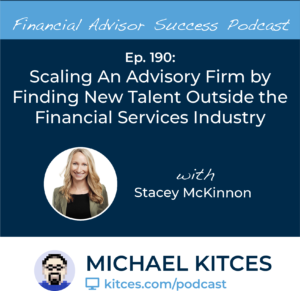In the early days of the financial advice industry, the nature of client relationships was primarily transactional, and any “financial planning” that happened was done purely from the perspective of determining a client’s needs so that the advisor could get paid for implementing a product with them to meet that need. That transactional relationship meant that advisors could work with anyone them meet – or at least anyone who had an interest and the financial wherewithal to buy their products – and since there wasn’t any value to meet with the client again until there was another opportunity to implement another product, an advisor would need potentially several hundred clients to be able to call back upon over time in order to make a living. However, as the advice industry has increasingly moved towards a recurring-revenue model (where advisors provide ongoing advice and generate ongoing fees), the number of clients that any advisor needs to serve has decreased dramatically, and the biggest limiter to an advisor’s practice is the number of ongoing clients they can support with a limited amount of time in the week, month, and year. Which means that it’s become increasingly important for advisors to focus on the operational efficiency of their financial planning practice.
In recent years, a growing number of financial advisors have begun to focus into niches and specializations as a way to differentiate themselves in an increasingly crowded advice marketplace. But those who have focused on a particular target clientele have also begun to note that it’s possible to run a more efficient (and more profitable) business by serving a client base that shares similar characteristics, as it means that an advisor can develop a deep and repeatable expertise to increase their capacity to serve more clients (and reduce the time it takes to provide financial planning to each).
Yet, in practice, actually committing to serve ‘just’ one certain type of client and ‘niche down’ is a major decision. As while it might seem ‘logical’, the idea of actively excluding prospective clients outside of their niche is downright daunting, to say the least, and up to this point, there’s been little hard evidence to support the time and efficiency value of having a niche. Until now.
By analyzing data from both the 2019 Kitces Research Study on Advisor Marketing and the 2020 Financial Planning Process Kitces Research Study, our analysis shows that there is indeed material efficiency value in focusing on a niche clientele to serve.
Specifically, our research analysis finds that top advisors with a niche (versus top advisors without a niche):
- Spend 150+ more hours every year on high-value, client-facing activities (or 28% more time with clients and prospects, while spending 13% less time doing middle-office and back-office tasks)
- Are able to deliver a more focused and customized financial planning process (as not every possible area of financial planning is applicable to every particular niche)
- Serve an average of 14% more clients (since advisors with niches can more easily scale their practices)
- Have clients with an average of both 25% more investable assets and higher net worth
- Are able to set their AUM fees 9% higher, and generate 20% higher standalone planning fees
- Earn an average of $660,000 (versus $395,000 for non-niche advisors at the same income percentile)
Ultimately, the key point is that there are indeed clear and measurable advantages (in both the short- and long-term) when opting to serve a niche clientele. Not only do advisors enjoy greater efficiencies withing their practices (by spending more time on the most value-added activities and less time on the least productive business tasks and stages of the financial planning process, and by offering a more concentrated, specialized planning approach), they charge more for their advice, serve more – and more affluent– clients (or, conversely, have the option to reduce their number of total clients by focusing in on their most profitable clientele), and end out seeing substantially better bottom-line results. And any business decision that allows a professional to serve their clients better, and to see better business results is, at the end of the day, a positive for advisors and their clients!

 Welcome back to the 190th episode of Financial Advisor Success Podcast!
Welcome back to the 190th episode of Financial Advisor Success Podcast! Welcome back to the 189th episode of Financial Advisor Success Podcast!
Welcome back to the 189th episode of Financial Advisor Success Podcast!
